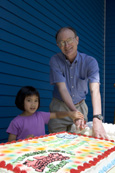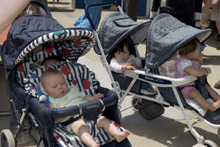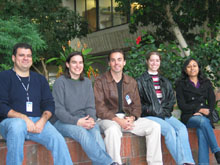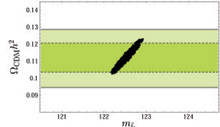 | Friday, June 3, 2005 |
|
Friday, June 3 3:30 p.m. DIRECTOR'S COFFEE BREAK - 2nd Flr X-Over 4:00 p.m. Joint Experimental Theoretical Physics Seminar - 1 West Speaker: Y. Kamyshkov, University of Tennessee Title: Baryon Number Violating Processes and the Proton Driver
Monday, June 6 |
|
Extended Forecast |
Secon Level 3 |
|
Friday, June 3 Beef Pepper Pot Buffalo chicken wings $4.85 Cajun Breaded Catfish $3.75 Sweet & Sour Pork Over Rice $3.75 Honey Mustard Ham & Swiss Panini $4.85 Double Stuffed Pizza $3.50 Carved Turkey $4.85 The Wilson Hall Cafe now accepts Visa, Master Card, Discover and American Express at Cash Register #1.
Wilson Hall Cafe Menu |
| Fermilab Today is online at: http://www.fnal.gov/today/ Send comments and suggestions to today@fnal.gov Fermilab Today archive Fermilab Today PDF Version Fermilab Result of the Week archive Fermilab Safety Tip of the Week archive Linear Collider News archive Fermilab Today classifieds Subscribe/Unsubscribe to |
|
Oddone Adds New Look At
New Perspectives, June 9-11 | ||
| ||
|
Fermilab's Graduate Students Association and Young Particle Physicists chapter will host the New Perspectives Conference on June 9-11, with an expanded program featuring Harrison Prosper of Florida State University, Steven Kahn of Stanford University, and incoming Fermilab director Pier Oddone as speakers on June 10. "This is the first year we have had speakers from multiple institutions," said GSA officer Jen Pursley. "We wanted to bring something new to the conference."
The wine-and-cheese reception on June 9 will feature posters on display for the annual competition. "It's a great experience for physicists at this level to start presenting their work," said Pursley. "We will be asked to do that a lot in the future." The GSA offers prizes to the three best posters, in memory of George Michail, a graduate student at Fermilab who died in a tragic automobile accident at the age of 28.
New Perspectives also offers the chance to see what is going on in the larger community of particle physics. "Oftentimes we get trapped in the specifics of our own research," said Pursley. "Graduate students welcome another perspective-even from someone working on the same experiment."
|
|
From New Scientist, June 2, 2005 Mystery rays could be sign of cosmic strings The mysterious gamma rays that emanate from the central bulge of our galaxy could arise from a seething tangle of "cosmic strings".
The gamma rays have a distinctive energy of 511 kiloelectronvolts, suggesting they are formed by the mutual annihilation of electrons and their antimatter counterparts, positrons. But where do the positrons come from? "This is the big mystery," says Tanmay Vachaspati, a string theorist at Case Western Reserve University in Cleveland, Ohio.
|
|
Theory Meets Experiment | ||
| ||
|
The future experiments conducted at the International Linear Collider
are expected to lead to important discoveries, providing deep insight
into the basic ingredients of our universe: energy, matter, space and
time. But how does one test whether an experiment will be able to live
up to its expectations?
Scientists working on the design of the ILC detector are beginning to establish a table of subatomic benchmark processes that the detector should be able to identify among gazillions of uninteresting background processes. From particles observed in past experiments to hypothetical processes predicted by theoretical models, the ideal detector would be able to identify them all. But in the real world, experimenters have to make compromises as they construct the detector. Theorists and experimenters work together and carry out computer simulations to test the capabilities of various detector designs. Together with four experimenters from Fermilab, Lancaster University and DESY Zeuthen, Fermilab theorists Marcela Carena and Ayres Freitas are studying a possible ILC benchmark process. The six scientists are investigating whether an ILC detector could measure the properties of stop quarks, hypothetical particles predicted by Supersymmetry. "Stops are of great theoretical interest," says Freitas. "If they exist and if they are light enough, they must have played an important role in the formation of matter in the early universe. They would have an effect on the total amount of dark matter." Electron-positron collisions at the ILC would produce pairs of stop quarks, which would yield a signal of two charm quark jets and missing energy. Detecting these decays and concluding the existence of stop quarks is an experimental challenge. "Anything else that creates two jets and large missing energy is a severe background," said Caroline Milstene, one of the four experimenters working on the project, during her presentation of the study at Fermilab in May. "We have to get rid of background that is a few orders of magnitude bigger than the signal."
The team showed that the ILC detector would be able to determine the mass
of a potential 122.6 GeV stop quark with a precision of +/- 0.4 GeV. Combining
this analysis with other ILC precision measurements, they found that the ILC
can test whether supersymmetric particles are the source of dark matter.
The study will be published later this year.
|
|
Register for the 2005 Fermilab Users' Meeting It's not too late to register for the 2005 Fermilab Users' Meeting. Join us for: - Presentations from representatives of DOE, NSF and OSTP, with Q&A - Latest results from Fermilab experiments - An insider's view of the EPP 2010 panel - Status of future initiatives at the lab and in HEP as a whole - Free catered dinner at the Users Center...but only if you REGISTER! Registration is free, and can be done online at the Users' Meeting Web site.
Classifieds Delayed
Join Fermilab's Weight Watchers Group
Children's Treasure Hunt Party - August 5 |



